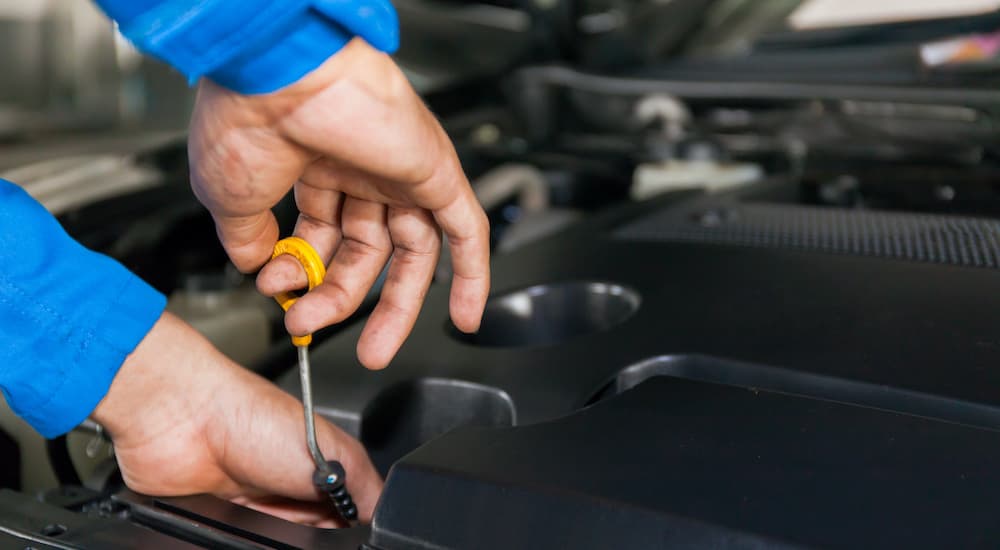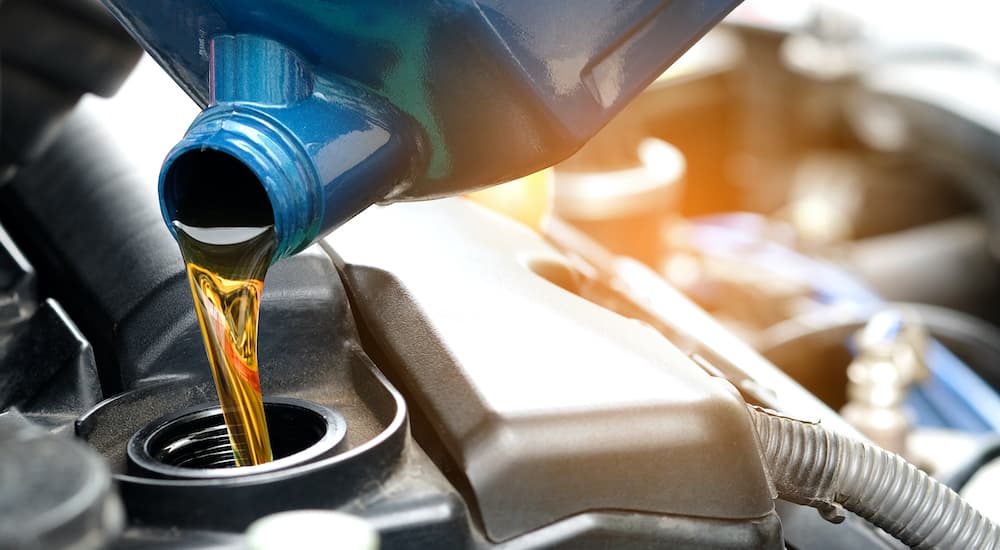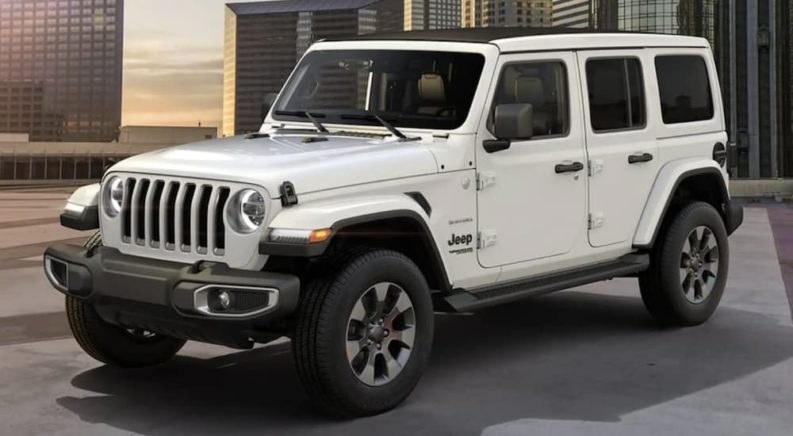When you own a brand new 2021 Jeep Wrangler, you need to properly maintain it and get as much life out of that sucker as you can. After all, when properly taken care of, a Wrangler can last you for decades. But unfortunately, life gets busy, and we don’t always have enough time to swing by our favorite Wrangler dealer for an oil change.
However, many Wrangler enthusiasts prefer the DIY route because it’s productive and it can save some cash. Regardless of why you need a DIY oil change, we’re here to help. We know that the DIY route can be tricky at times, especially for newer models. That’s why we’ve compiled this thorough guide. Follow these steps, and your new Jeep Wrangler will be refreshed in no time!
Before we get started, it’s important that you only follow this guide if you are changing the oil in a 2021 Jeep Wrangler. This guide is made specifically for 2019 to 2021 models, not older Wranglers or other Jeep models. Also, keep in mind that this guide is designed for the 2.0-liter I4 turbocharged engine.
Intermittently Checking Your Oil Level
Before your oil change warning comes on, it’s good to check your engine oil level every now and then. The official 2021 Jeep Wrangler Owner’s Manual recommends checking your oil at least once a month and waiting about 5 minutes after the engine is shut off before doing so.
The first step in checking your oil is to make sure your Jeep is on level ground. Then, you need to access your dipstick. For reference, the 2.0-liter turbocharged Wrangler’s dipstick is located directly to the left of the engine.
Simply pull out the dipstick, wipe it clean, and then reinsert it to see where the oil level lands. You want the oil level to stay in the cross-hatch markers on the stick. High oil levels can damage your engine just the same as low levels can, so this step is important. When your dipstick shows that you’re at the lowest engine oil level, you can add a quart of oil to reach a sufficient oil level.

Now, onto the oil change itself.
Step 1: Choose the Right Oil
You want to only use oils that are API SP/GF-6 certified, whether you use synthetic or non-synthetic oil. However, we recommend that you use synthetic oil. Do not use any engine oils that are not API (American Petroleum Institute) certified. We recommend using 5W30 full-synthetic oil by your brand of choice.
Step 2: Gather Materials
Make sure you have a 13mm socket wrench. You’ll also need a large drain pan that can hold up to 5 quarts of oil, 5 quarts of new engine oil, a funnel, a full-flow oil filter, and a clean rag. Since your Wrangler has high ground clearance, you probably don’t have to use ramps. However, if you prefer the additional height, car ramps are helpful. Lastly, you don’t have to have one, but an oil filter wrench is handy.
Step 3: Chock It!
For your own safety, make SURE that your vehicle is stationary! The best way to do this is by using official tire chock wedges. Some people do use 2×4 pieces of wood, but it’s safest to purchase an actual tire wedge.
Step 4: Warm the Engine
The best time to change your oil is 20 to 30 minutes after you’ve driven it. Or, you can let your vehicle run for no longer than 2 to 3 minutes to reach the perfect oil temperature. Either way, the oil temp will be roughly 100 degrees. The reason you want to do this is because the oil’s thickness decreases when warm, but the oil isn’t so hot that it’s dangerous and can burn you.
Step 5: Check the Engine Oil
Even if you routinely check your Wrangler’s engine oil, check it again before you start the official oil change. Make sure that nothing is wrong and that no additional maintenance is needed. Look for negative signs such as sludgy oil and irregular texture.
Step 6: Drain the Oil
Now it’s time to get under the vehicle and drain the oil. This is the time to use your tire ramps and wedges if you have them. Get under your vehicle and use your socket wrench to remove the drain plug, letting the oil drain down into your drain tub. Make sure to reinstall the drain plug after the oil pan is empty!
Step 7: Replace the Oil Filter
You’re expected to change your oil filter with EVERY oil change. Even if it looks okay, it’s important to still put the new filter on. You can use your oil filter wrench to remove the old filter, but reinstall the new one by hand to make sure you don’t over tighten it. Set aside the old oil filter for now, then safely and economically dispose of it later. Put the new oil filter on, then reattach the drain plug, securing it tightly.
Step 8: Add The New Oil
Now for the fun part! Bring out the oil funnel, place it in the oil fill location (not the dipstick location), which is at the bottom right of your engine under the hood, and pour 5 quarts of engine oil into the funnel. Put the oil cap back on, secure the hood, and the main steps are finished!
Step 9: Make Additional Changes if Needed
You’ll want to start your Wrangler’s engine, letting the oil warm up so that you can get a new, accurate oil reading. You may see that your oil level is still low. If that’s the case, top it off, but be very careful not to overfill your oil pan. In the event that this happens, you’ll need to drain the oil and start the process over. Just make sure you drain the oil into a separate, clean pan.

Reset Your Oil Change Indicator!
You want to have an accurate oil reading, so it’s important to reset your oil change indicator. This is an easy to forget step that may get away from you if you don’t do it right after the oil change is finished.
To do this on a 2021 Jeep Wrangler, simply:
- Turn on the vehicle
- Use your steering wheel navigation to access the dash’s “Vehicle Info” section
- From here, navigate to “Oil Life”
- Then, press and hold down the “OK” button located on the steering wheel
- Re-check your oil life and make sure it has reset to 100%. Now you’re good to go!
Recycle Your Used Oil
Now that the process is over, it’s time to clean up. It may seem inconvenient, but always remember that it’s important to dispose of your engine oil properly. The best way to do this is by placing your used oil in a clean, unused polyethylene container. Or, you can stay one step ahead by purchasing a resealable oil pan or by reusing an empty oil container. Just make sure to use your funnel when you choose the latter option.
Why is it important to recycle your oil? If you love Wranglers, we know that you likely love nature and wildlife. After all, you’re spending much of your time amongst the woodland creatures. Simply disposing of the oil by pouring it out will directly affect the environment, polluting the area with toxic metals which are hazardous to both people and wildlife.
Hit the Road!
Now that your oil is nice and clean, you can commute during the week and hit the trails on the weekends without a single worry. You saved some money and proved to yourself that you’re a DIY mechanic!

